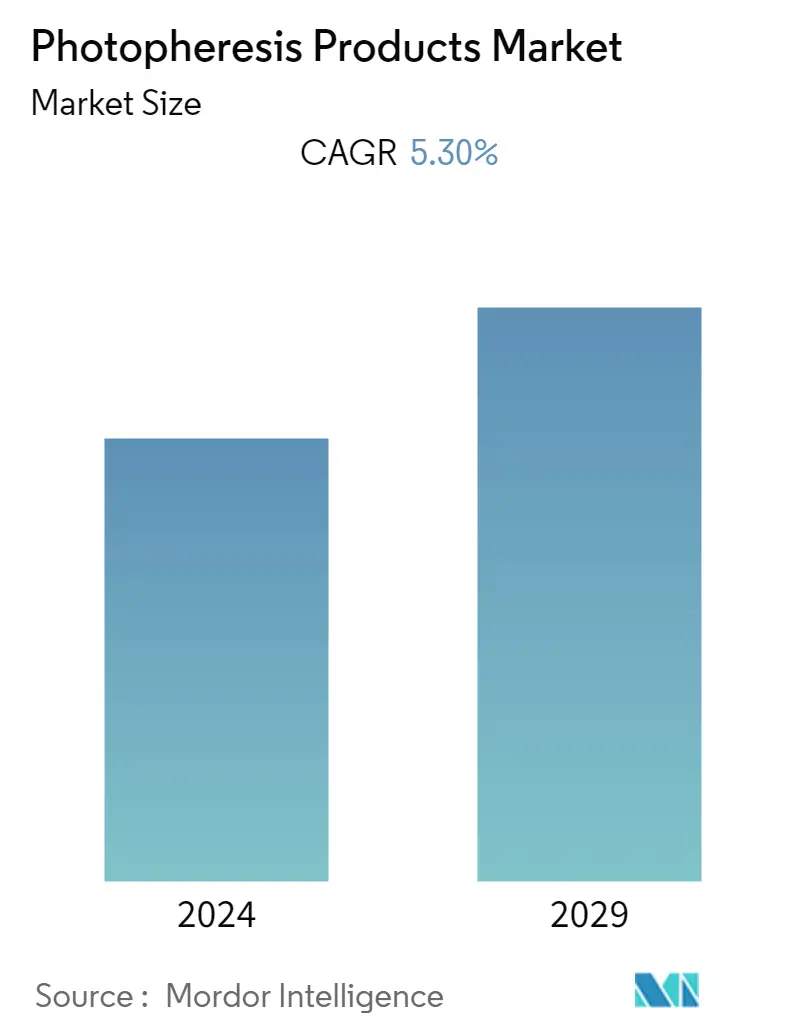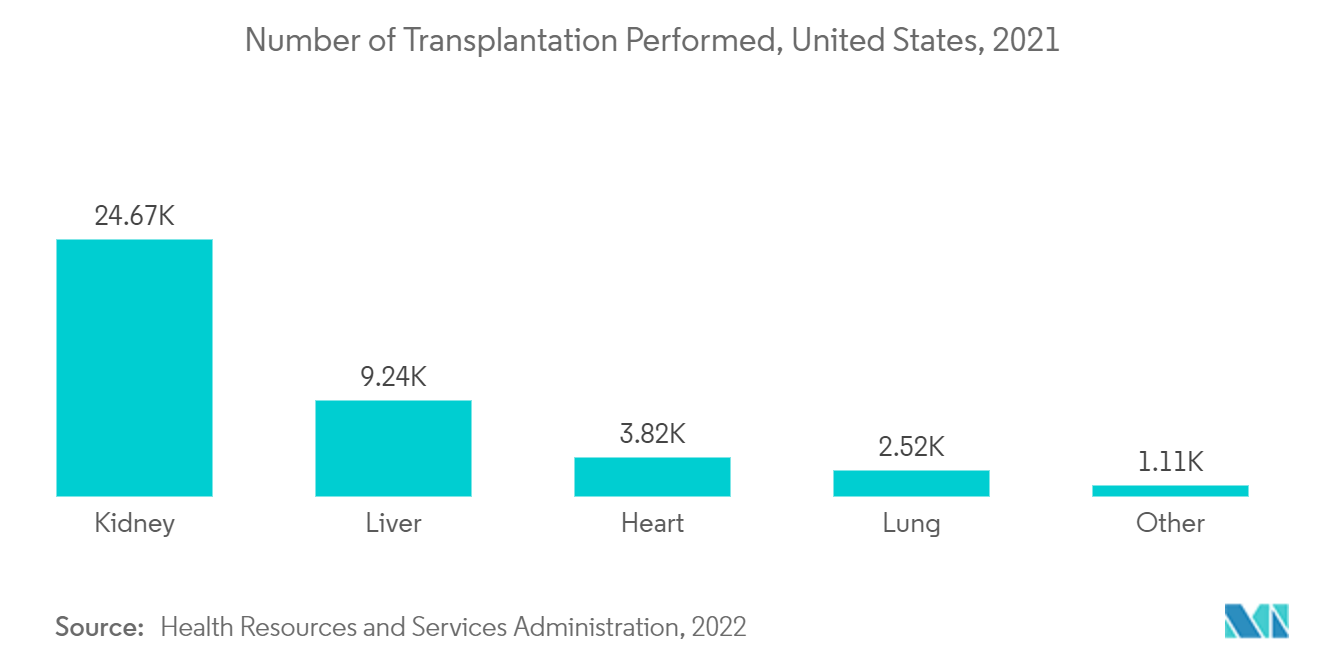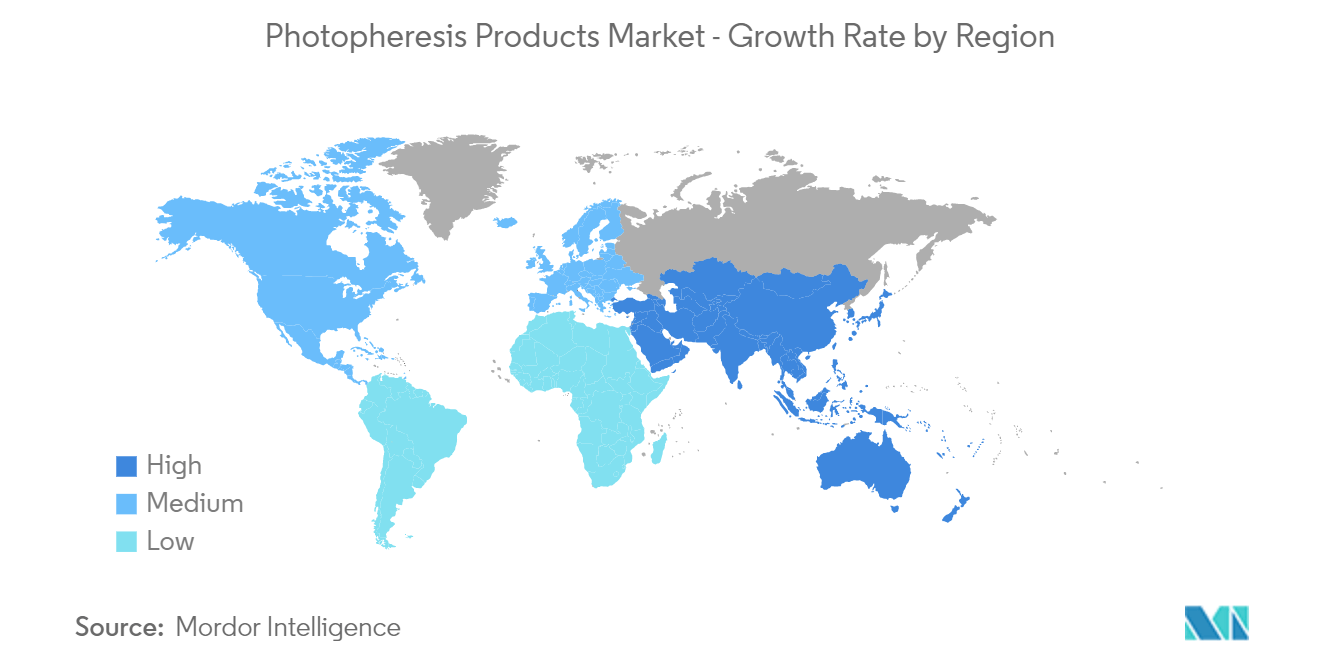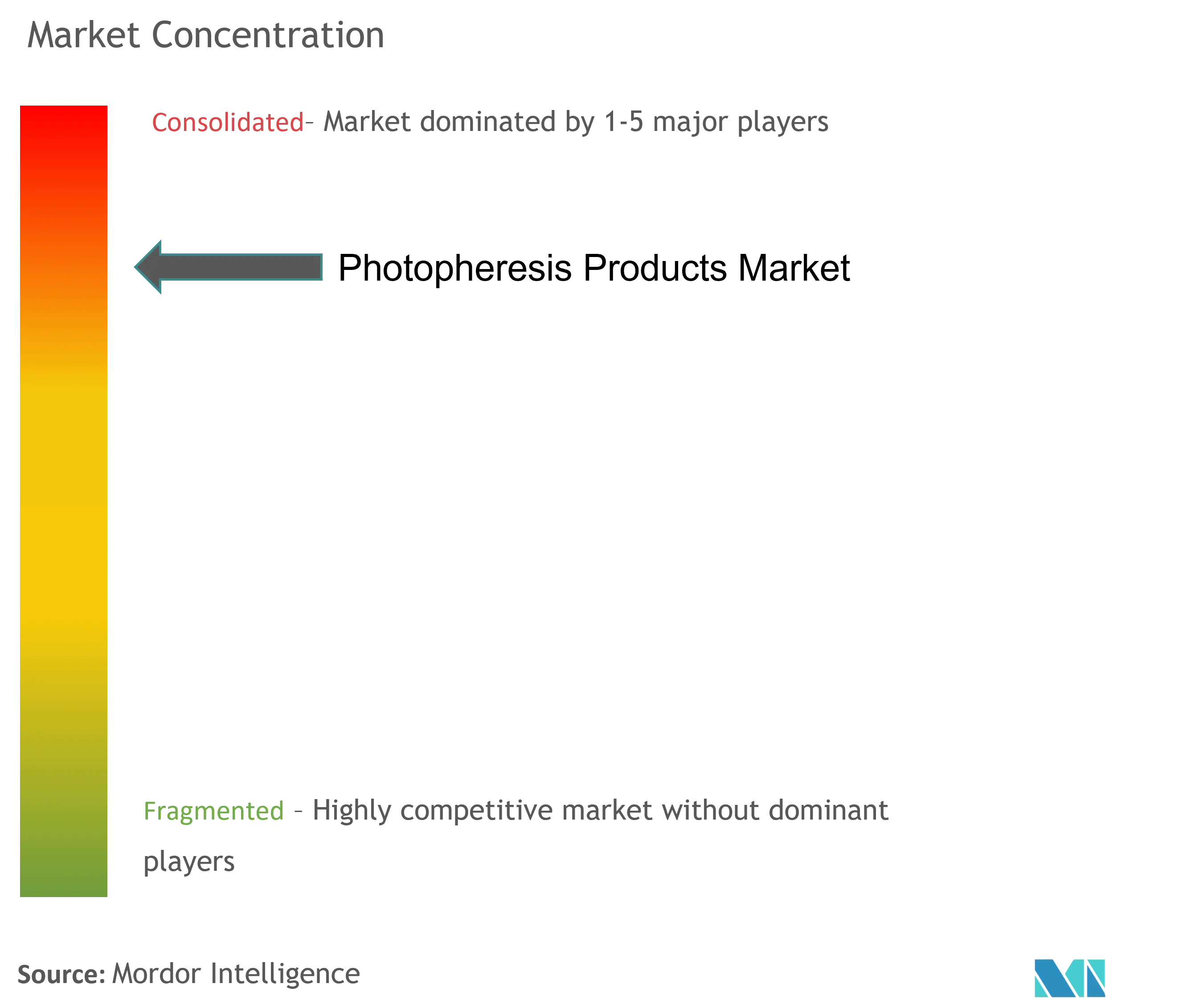Photopheresis Products Market Size

| Study Period | 2019 - 2029 |
| Base Year For Estimation | 2023 |
| Forecast Data Period | 2024 - 2029 |
| CAGR | 5.30 % |
| Fastest Growing Market | Asia Pacific |
| Largest Market | North America |
Major Players
*Disclaimer: Major Players sorted in no particular order |
Photopheresis Products Market Analysis
The photopheresis products market studied was anticipated to register a CAGR of 5.3% during the forecast period.
- COVID-19 significantly impacted the market studied due to the stringent lockdown restriction and half of all the non-elective procedures during the early pandemic. For instance, according to the study published in Transplantation and Cellular Therapy in January 2021, oncologic and hematopoietic stem cell transplantation utilization and delivery were drastically impacted by the continuing global COVID-19 pandemic, including delays in cancer diagnosis and therapy.
- Furthermore, according to the European Journal of Cancer study published in October 2021, Extracorporeal photopheresis (ECP) was considered high-risk therapy in cutaneous lymphomas during the COVID-19 pandemic because it required travel to the clinic or hospital. Such studies explain a slight decline in the photopheresis products market. However, in the post-pandemic period, the market has grown significantly after increased travel restrictions and the restart of organ transplantations and cancer treatment in hospitals. The market may reach the pre-pandemic levels by mid of 2023.
- The significant factor attributing to this market's growth is the demand for photopheresis products which is growing rapidly. Rising autoimmune disease prevalence and increasing numbers of cases of organ transplantation are the major factors boosting the global market for photopheresis products.
- According to the Global Observatory on Donation and Transplantation 2021, 144,302 organs were transplanted globally in 2021. This includes 92,532 kidneys, 34,694 livers, and 8,409 hearts. Furthermore, according to the United Network for Organ Sharing 2022 results, more than 25,000 kidney transplants were carried out in the United States, with an increase of 3.4% from 2021. This includes liver (9,528), heart (4,111), and lung (2,692) transplants. Such a huge number of organ transplants globally and in developed regions such as the United States is anticipated to increase the adoption of photopheresis products in organ transplantations, driving the market growth.
- Additional factors such as the rising healthcare infrastructure, technological advancement, and growing geriatric population will further drive the market for photopheresis products during the forecast period. The key market players' ongoing initiatives in photopheresis, such as the approvals and launch of innovative products, are anticipated to drive the market studied due to increased adoption.
- For instance, in January 2021, Japan's Ministry of Health, Labour and Welfare (MHLW) approved the CELLEX extracorporeal photopheresis (ECP) system developed by Mallinckrodt Inc, a global biopharmaceutical company for the treatment of steroid-resistant or intolerant chronic graft versus host disease (cGvHD) in adults.
- Therefore, the factors such as rising organ transplantations, rising prevalence of autoimmune diseases, and rising initiatives from the key market players are anticipated to drive market growth. However, the low adoption of photopheresis in pediatric patients and a lack of skilled professionals are expected to hamper the market growth.
Photopheresis Products Market Trends
Chronic Graft Versus Host Disease (GvHD) is Expected to Hold a Significant Market Share in the Market Studied.
- Chronic Graft-versus-host disease (GvHD) is a systemic disorder that happens when the graft's immune cells recognize the host as foreign and attack the recipient's body cells. It is a common complication after an allogeneic hematopoietic stem cell transplant (HCT). In GvHD, the recipient's body is attacked by the donated bone marrow or peripheral blood stem cells as they perceive it as foreign.
- Extracorporeal photopheresis (ECP) remains one of the subsequent therapeutic choices in the treatment of GvHD, thereby driving market growth. According to the study published in Medicine in November 2022, with an overall response rate ranging from 31% to 93% and the maximum efficacy reported for individuals with skin involvement, ECP's effectiveness in treating cGVHD is well-documented.
- It should be noted that for a clear visual result, prolonged ECP is typically required. In addition, according to the study published in the American Society for Transplantation and Cellular Therapy in November 2022, ECP is an effective immunomodulatory therapy with mild adverse events in GvHD. Such advantages and effectiveness of photopheresis in GvHD are expected to increase adoption, driving the segment growth.
- In addition, rising initiatives from the national governments for the implementation of ECP for GvHD are expected to bolster segment growth over the forecast period. For instance, in March 2022, the Government of Australia passed a regulation for initial ECP treatment, and continuing ECP treatment will be introduced for patients with GvHD following allogeneic hematopoietic stem cell transplantation. Such initiatives will lead to increased adoption of ECP in GvHD, driving segment growth.
- Therefore, the rising initiatives from the government and the importance of photopheresis in GvHD are the factors expected to drive the segment growth.

North America is Holds a Significant Share and Expected to do the Same in the Forecast Period
- The factors driving the market in North America include rising organ donations, a strong foothold and rising initiatives of the key market players, and developed healthcare infrastructure, among others.
- According to the United States Department of Health and Human Services, in March 2022, more than 40,000 transplants took place in 2021, that include 24,670 kidney and 9,236 liver transplantations, among others.
- In addition, according to the Canadian Institute of Health Information, in June 2022, a total of 2,782 organ transplants were performed in Canada in 2021, including 78% deceased donor organs and 21% living donor organs. Such organ transplantation will drive market growth in the region due to the increased adoption of photopheresis products to overcome organ transplant rejection.
- Furthermore, the rising initiatives from the key market players are also expected to drive market growth in the region. For instance, in July 2021, Terumo Blood and Cell Technologies launched a direct offering for physicians to perform extracorporeal photopheresis immunotherapy (ECP) procedures at the patient's bedside.
- Terumo Blood and Cell Technologies is a medical technology company that specializes in a portfolio of products, software, and services for blood collection, therapeutic apheresis, and cellular technologies. Such an initiative will lead to increased adoption of photopheresis products in blood collection and processing, driving market growth.
- Moreover, the presence of blood processing centers and advanced apheresis are also some of the main factors ensuring the dominance of the region. Therefore, owing to the factors such as rising organ transplantation and rising initiatives from the key market players are expected to drive market growth in the region.

Photopheresis Products Industry Overview
The photopheresis products market is consolidated and consists of a few major players. The factors owing to the competition included prominent players vigorously making collaborations and acquisitions with other companies to consolidate their market positions across the globe. Some of the companies operating in the market are Haemonetics Corporation, Fresenius Kabi AG, Macopharma, Mallinckrodt Pharmaceuticals, and PIT Medical Systems.
Photopheresis Products Market Leaders
-
Fresenius Kabi AG
-
Macopharma
-
Mallinckrodt Pharmaceuticals
-
PIT Medical Systems
-
Haemonetics Corporation
*Disclaimer: Major Players sorted in no particular order

Photopheresis Products Market News
- In September 2022, UAE opened a new apheresis unit in the Sheikh Shakhbout Medical City (SSMC) as a collaboration between Abu Dhabi Health Services Company (SEHA) and Mayo Clinic. Sheikh Shakhbout Medical City widens the treatment scope for diseases, including rare lymphoma of the skin.
- In August 2022, Ikaria Australia Pty Ltd, a Mallinckrodt Pharmaceuticals company, launched THERAKOS CELLEX Photopheresis System to the Australian market. The CELLEX instrument performs the extraction, treatment, and reinfusion of white blood cells for an integrated, closed photopheresis procedure.
Photopheresis Products Market Report - Table of Contents
1. INTRODUCTION
- 1.1 Study Assumptions and Market Definition
- 1.2 Scope of the Study
2. RESEARCH METHODOLOGY
3. EXECUTIVE SUMMARY
4. MARKET DYNAMICS
- 4.1 Market Overview
-
4.2 Market Drivers
- 4.2.1 Rise in Prevalence of Autoimmune Diseases
- 4.2.2 Increasing Technological Advancements
-
4.3 Market Restraints
- 4.3.1 Low Adoption of Photopheresis in Pediatric Patients and Lack of Skilled Professionals
-
4.4 Porter's Five Forces Analysis
- 4.4.1 Threat of New Entrants
- 4.4.2 Bargaining Power of Buyers/Consumers
- 4.4.3 Bargaining Power of Suppliers
- 4.4.4 Threat of Substitute Products
- 4.4.5 Intensity of Competitive Rivalry
5. MARKET SEGMENTATION
-
5.1 By Product Type
- 5.1.1 Open System
- 5.1.2 Closed System
-
5.2 By Application
- 5.2.1 Graft versus Host Disease
- 5.2.2 Cutaneous T-Cell Lymphoma
- 5.2.3 Transplant Rejections
- 5.2.4 Autoimmune Diseases
-
5.3 By End-User
- 5.3.1 Hospitals
- 5.3.2 Ambulatory Centers
- 5.3.3 Other End-Users
-
5.4 Geography
- 5.4.1 North America
- 5.4.1.1 United States
- 5.4.1.2 Canada
- 5.4.1.3 Mexico
- 5.4.2 Europe
- 5.4.2.1 Germany
- 5.4.2.2 United Kingdom
- 5.4.2.3 France
- 5.4.2.4 Italy
- 5.4.2.5 Spain
- 5.4.2.6 Rest of Europe
- 5.4.3 Asia-Pacific
- 5.4.3.1 China
- 5.4.3.2 Japan
- 5.4.3.3 India
- 5.4.3.4 Australia
- 5.4.3.5 South Korea
- 5.4.3.6 Rest of Asia-Pacific
- 5.4.4 Middle East and Africa
- 5.4.4.1 GCC
- 5.4.4.2 South Africa
- 5.4.4.3 Rest of Middle East and Africa
- 5.4.5 South America
- 5.4.5.1 Brazil
- 5.4.5.2 Argentina
- 5.4.5.3 Rest of South America
6. COMPETITIVE LANDSCAPE
-
6.1 Company Profiles
- 6.1.1 Haemonetics Corporation
- 6.1.2 Fresenius Kabi AG
- 6.1.3 Macopharma
- 6.1.4 Mallinckrodt Pharmaceuticals
- 6.1.5 PIT Medical Systems
- 6.1.6 Terumo Corporation
- *List Not Exhaustive
7. MARKET OPPORTUNITIES AND FUTURE TRENDS
** Subject To AvailablityPhotopheresis Products Industry Segmentation
As per the scope of the report, photopheresis (also known as extracorporeal photopheresis (ECP)) is a medical treatment that removes blood through a machine and isolates white blood cells. These isolated white cells are exposed to a medication called 8-methoxy psoralen followed by UVA irradiation before returning the blood to the patient. Photopheresis is used to treat medical conditions such as lung transplant rejection, heart transplant rejection, chronic graft versus host disease (GVHD), and cutaneous T-cell lymphoma (CTCL).
The photopheresis products market is segmented by product type (open system and closed system), application (graft versus host disease, cutaneous T-cell lymphoma, transplant rejections, and autoimmune diseases), end-user (hospitals, ambulatory centers, and other end users), and geography (North America, Europe, Asia-Pacific, Middle East and Africa, and South America).
The report offers the value (in USD million) for the above segments
| By Product Type | Open System | |
| Closed System | ||
| By Application | Graft versus Host Disease | |
| Cutaneous T-Cell Lymphoma | ||
| Transplant Rejections | ||
| Autoimmune Diseases | ||
| By End-User | Hospitals | |
| Ambulatory Centers | ||
| Other End-Users | ||
| Geography | North America | United States |
| Canada | ||
| Mexico | ||
| Geography | Europe | Germany |
| United Kingdom | ||
| France | ||
| Italy | ||
| Spain | ||
| Rest of Europe | ||
| Geography | Asia-Pacific | China |
| Japan | ||
| India | ||
| Australia | ||
| South Korea | ||
| Rest of Asia-Pacific | ||
| Geography | Middle East and Africa | GCC |
| South Africa | ||
| Rest of Middle East and Africa | ||
| Geography | South America | Brazil |
| Argentina | ||
| Rest of South America |
Photopheresis Products Market Research FAQs
What is the current Photopheresis Products Market size?
The Photopheresis Products Market is projected to register a CAGR of 5.30% during the forecast period (2024-2029)
Who are the key players in Photopheresis Products Market?
Fresenius Kabi AG, Macopharma, Mallinckrodt Pharmaceuticals, PIT Medical Systems and Haemonetics Corporation are the major companies operating in the Photopheresis Products Market.
Which is the fastest growing region in Photopheresis Products Market?
Asia Pacific is estimated to grow at the highest CAGR over the forecast period (2024-2029).
Which region has the biggest share in Photopheresis Products Market?
In 2024, the North America accounts for the largest market share in Photopheresis Products Market.
What years does this Photopheresis Products Market cover?
The report covers the Photopheresis Products Market historical market size for years: 2019, 2020, 2021, 2022 and 2023. The report also forecasts the Photopheresis Products Market size for years: 2024, 2025, 2026, 2027, 2028 and 2029.
Photopheresis Products Industry Report
Statistics for the 2024 Photopheresis Products market share, size and revenue growth rate, created by Mordor Intelligence™ Industry Reports. Photopheresis Products analysis includes a market forecast outlook to for 2024 to 2029 and historical overview. Get a sample of this industry analysis as a free report PDF download.



